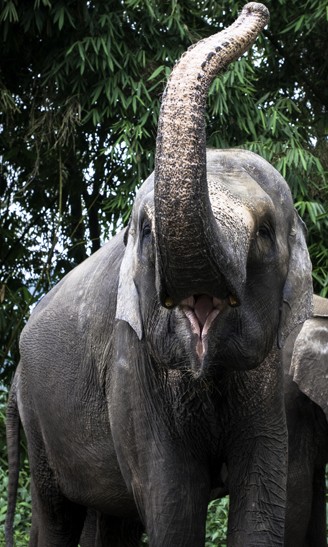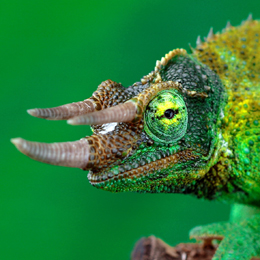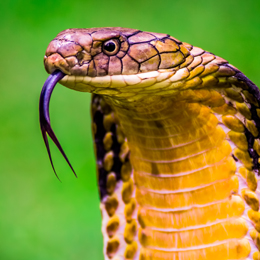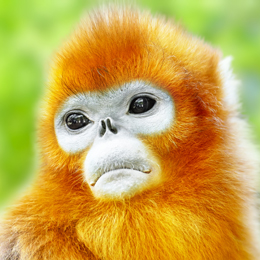Sumatran Elephants
As the name suggests, the Sumatran Elephant is endemic to the island of Sumatra in Indonesia. It is one of the three sub-species of Asian Elephant that also includes the Indian and the Sri Lankan Elephant. However, this sub-species has become an endangered species due to the drastic decline of their population in the last 75 years. It has been estimated that these animals have lost about 80 % of their total population within just a span of three generations due to loss of habitat, mainly caused by the expansion of palm-oil plantations.
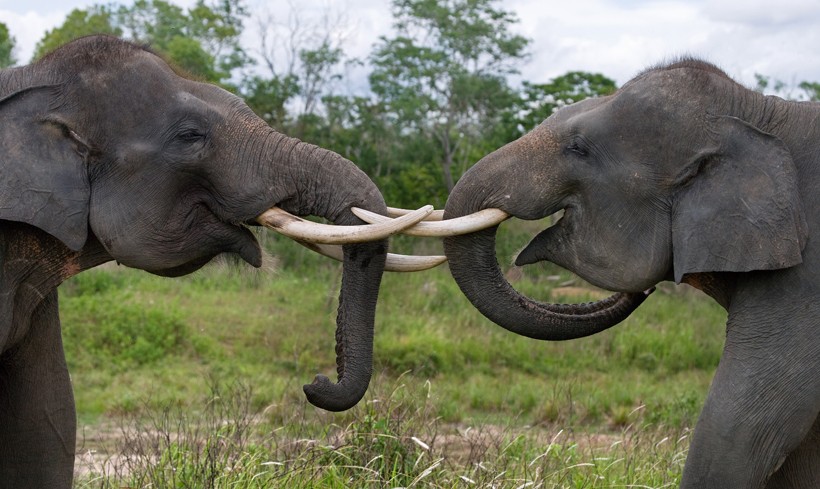
Sumatran elephants playing with each other
?
Image credits: GUDKOV ANDREY/Shutterstock
As a sub-species of Asian Elephant, the Sumatran Elephants are considerably smaller in size than the African Elephants. This sub-species can reach a maximum height of 3.2 m(10.5 ft) and can weigh as much as 4000 kg (8,800 lb). Compared to Sri Lankan and Indian Elephants, the Sumatran subspecies have a lighter skin color and minimum depigmentation marks on the body. The females are smaller and lighter than the males and have shorter tusks that are barely visible. In comparison to the tusks of the other Asian sub-species, the tusks of the male Sumatran subspecies are relatively shorter.
The average lifespan of the Sumatran Elephant is 60 years. It may vary depending on food supply and living condition. In captivity, the Sumatran Elephants that were provided with adequate food and given proper health treatment have lived up to the age of 75 years. On the other hand, many elephants living in the wild could barely reach the minimum age of 60 years due to malnourishment and various life threats.
Relative species
The Sumatran Elephant is a subspecies of the Asian Elephant (Elephas maximus) and shares its genus with the Sri Lankan (E. m. maximus) and Indian Elephant (E. m. indicus). Out of the three recognized subspecies of Asian Elephant, the Sumatran Elephant is the smallest in size. The males of this species also bear the smallest tusks. Unlike the Indian and Sri Lankan Elephant, the skin coloration of Sumatran Elephant is considerably lighter. These elephants also exhibit very less depigmentation marks on their skin whereas the Sri Lankan Elephants have very distinctive skin discoloration marks on their forehead, ears and belly.
Anatomy and Characteristics
The Sumatran Elephants have light gray colored skin. The wrinkled skin of these elephants is movable and contains a large number of nerve centers. Nevertheless, the skin of Sumatran Elephant is relatively smoother than that of the African Elephants and contain very indistinctive depigmented (skin discoloration) marks on their trunk, neck and ears. Moreover, elephants have significant thick skin which protects them from bumps, bites, scratches and adverse weather.
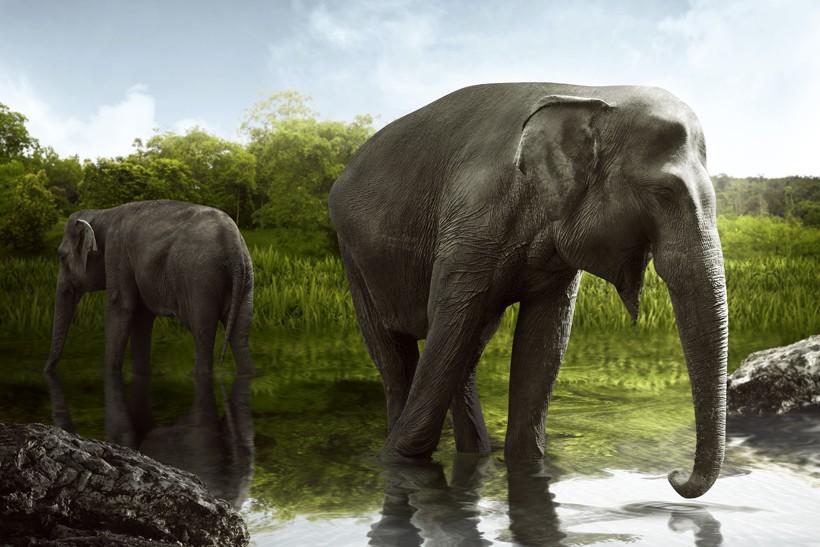
Sumatran Elephant drinking water
?
Image credits: leolintang/Shutterstock
The shoulder height of these elephants ranges from 2 – 3.2 m (6.6 – 10.5 ft) and they weigh 2,000 to 4,000 kg (4,400 - 8,800 lb). Similar to other subspecies of Asian Elephant, the head of Sumatran Elephant is the highest point of their body. The back profiles of the males are convex while the females exhibit a more leveled back.
The trunk of the Sumatran Elephant is actually an elongation of their nose in combination with the upper lip. The nostrils are located at the tip of the trunk which also contains one finger-like protrusion. The trunk of a Sumatran Elephant contains over 60,000 muscles and is one of the most distinctive features of their body.
The trunk is very sensitive and is also the most multipurpose prehensile organ that is used for breathing, feeding, touching, dusting, watering, grasping, defense, washing, pinching, communication and sound production. Moreover, the trunk in combination with the Jacobson’s organ provides the elephant with a very strong sense of smell.
Habitat
Native to Sumatra, the Sumatran Elephant lives across the tropical moist forest of this region. In the past, these elephants occurred in large numbers all across the Sumatran Island with their largest population inhabiting the lush green forests of the Riau Province.
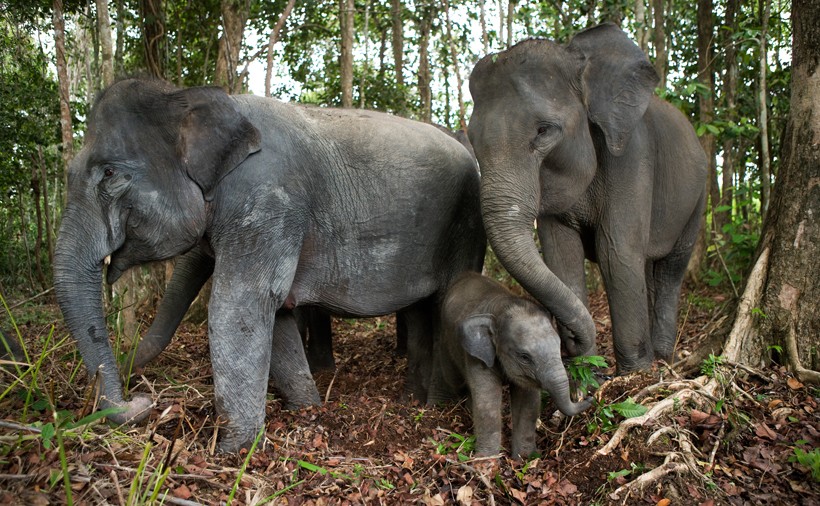
Sumatran Elephants in the jungle
?
Image credits: GUDKOV ANDREY/Shutterstock
In an island-wide survey carried out in 1985, it was estimated that about 4,800 elephants occurred in 44 populations in all the 8 mainland provinces of this island. The Lampung Province, the Bukit Barisan Selatan National Park and the Way Kambas National Park were the major areas inhabited by these giants. However, these populations quickly declined and by 2008 the Sumatran Elephant became locally extinct in the province of West Sumatra and was at high risk of meeting the same fate in the North Sumatra Province.
The Sumatran Elephants mainly prefer the natural lowland areas as their habitat but due to rapid deforestation caused by commercial plantation these creatures have suffered tremendously and forced to compromise with their preferred habitat. Moreover, due to the requirement of large amounts of food, the elephants need a minimum home range of 20 square kilometer in a day. Therefore, they are forced to cover long range distances every day in search of food. Sumatra being the sixth largest island in the world and home to most diverse rainforests provided the Sumatran Elephants with more than enough food and space earlier. Unfortunately, the fast disappearing forests on this tropical island due to various human-induced factors has become one of the biggest threats to the survival of these mega creatures.
Diet and Predation
Diet
Sumatran Elephants are strictly herbivorous and consumes approximately 150 kg (330 lb) of plant matter each day. They are grazers as well as browsers with their diet involving over 112 different species of plants. They are able to eat various types of vegetation that include grasses, leaves, shoots, fruits, seeds and barks. During the dry season, they browse more often with barks covering a major portion of their diet. These elephants also need huge amounts of water for quenching their thirst. An adult Sumatran Elephant drinks 80 – 200 liters water per day. As a result, these mega-herbivores prefer to forage in the areas with nearby fresh water sources.
The unusually large amount of diet of Sumatran Elephants also plays a crucial role in the well-being of the ecosystem. The digestive system of an elephant is able to digest only half of their total ingested food. Therefore, with their habit of traveling long distances every day, these animals naturally disperse the seeds of different plant species all throughout the forests when they defecate. That is why they are also called Forest Gardeners. In fact, many species of plants depend solely on elephants for expansion of their seeds which in turn contributes to the increase of forest land. Moreover, the lush expansion of forest habitat also benefits many other smaller species like the Sumatran Rhino, Orangutan and the nearly extinct Sumatran Tiger. Hence, the Sumatran Elephants represent biodiversity within its habitat and conserving these animals greatly contributes to ecological integrity.
Predation
Due to the large size of the adult Sumatran Elephants, they are rarely attacked by their natural predator which is the Sumatran Tiger. However, the calves that stroll far away from their herd, or gets separated from its mother, might get predated by the Sumatran Tiger. But, as a result of the rapid declination of the Sumatran Tiger’s population, which has pushed this animal to the brink of extinction, this tiger predating on Sumatran Elephants has become a rare event.
On the other hand, humans have become the primary predator of the Sumatran Elephant. In addition to poaching, the rapid deforestation and expansion of human settlement in the Sumatran Island has become a major threat to these majestic creatures. This has already resulted that this animal has been listed in the category of Critically Endangered species in 2012. Moreover, with the unchecked continuation of these factors, the Sumatran Elephants might completely disappear from their wild habitats in near future.
Reproduction and Life Cycle
Similar to other elephants, the bulls of Sumatran Elephants also engage in fighting for getting access to receptive or estrous females. Sexual maturity among bulls usually takes place between 12 and 15 years. Sexually mature bulls under the age of 20 often go through an annual phase of heightened sexual excitement known as ‘musth.’ During this period of musth, the testosterone level in their body increases to such extent that it makes the bull extremely aggressive. Secretions containing pheromones can then be seen discharging from the bull’s paired temporal glands located between their eye and ear.
The gestation period of all the subspecies of Asian Elephant, including the Sumatran Elephant, ranges from 18 to 22 months. The female Sumatran Elephants usually give birth to a single calf while twins are rare. The parturition lasts only for about 10 seconds and occurs at night. Similar to other herbivores, the infant of Sumatran Elephants becomes able to stand on its own within 10 – 30 minutes after birth. At the time of birth, the newborn calf weighs around 100 kg (220 lb).
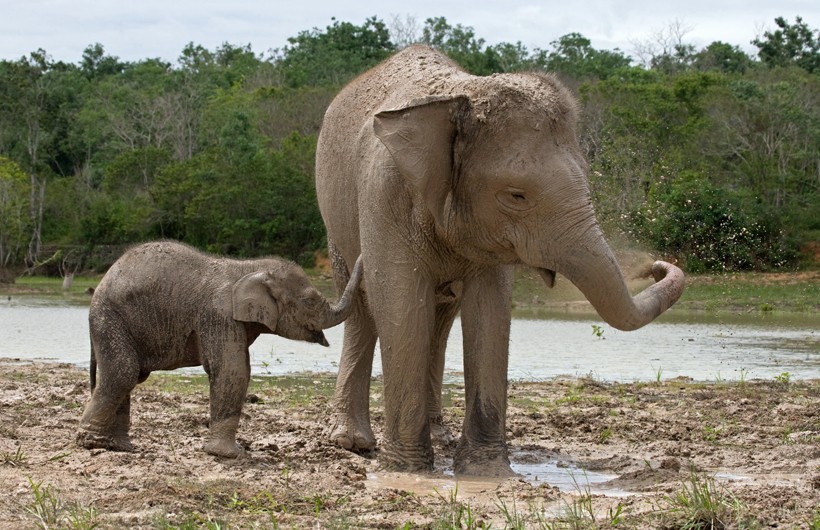
Newborn calf with mother
?
Image credits: GUDKOV ANDREY/Shutterstock
The calf suckles for about 3 years and is weaned till 4 or 5 years of age. A female Sumatran Elephant with a calf does not breed until her first calf is completely weaned in order to make sure that her offspring is fully tended before it becomes semi-independent. The female calves usually stay with their mother’s herd for the rest of their lives, while male calves are chased away after attaining sexual maturity. Moreover, the female elephants of this species stop reproducing after the age of 60.
Behavior, Communication & Intelligence
Sumatran Elephants are social animals that live in large herds consisting mainly of females and their calves. They use loud trumpets as well as infrasonic sounds for communicating with each other. Along with a good memory, the degree of intelligence among these elephants is also very high. Regarding cognitive abilities, elephants are placed in the same category as the great apes due to their ability to comprehend the use of tools. These animals exhibit various types of behavior that include learning, grief, mimicry, altruism, allomothering (non-maternal infant care), use of tools, co-operation, compassion, self-awareness and memory.
The herds of Sumatran Elephants are made up mostly by females along with their calves. Most of these elephants are often related. The eldest female of the herd, also known as the matriarch, has the responsibility of leading the herd. She shows the other herd members the various routes for finding proper food and water.
The elephants show a strong bond with each other and exhibit very affectionate behavior towards the calves. The young calves can often be seen frolicking with other calves and trotting behind their mothers by holding their tails. Moreover, the female Sumatran Elephants are very protective towards their young ones and can lay down their own life in order to protect the offspring. This is also a reason for the fast decreasing elephant population. With illegal animal trade being widespread on this island, the baby elephants are captured frequently as part of this illegal animal trading. This often ends up with killing the mother or injuring her severely while she attempts to protect her calf.
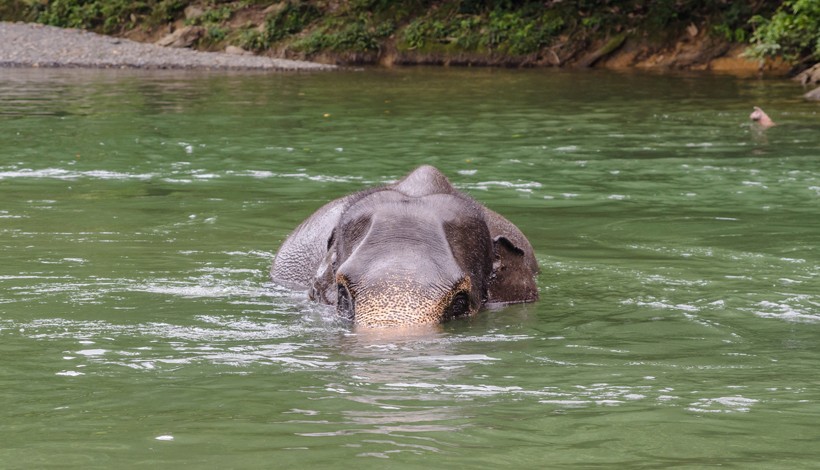
Sumatran Elephant in lake in Tangkahan, Sumatra
?
Image credits: lenisecalleja.photography/Shutterstock
Another strange behavior displayed by elephants is their ritual of grieving for the dead. When one of their herd members dies, the other individuals come around the dead elephant and sniff and touch the dead elephant’s forehead with their trunk. Instead of just moving along their way, the herd members stay near the dead animal for a while before resuming their journey. They display the same behavior when they come across an elephant’s carcass who hasn’t been a member of their own herd.
Population and Conservation
Almost thirty years ago, the Sumatran Elephants occurred in 44 populations in all the Sumatran Provinces with the largest population being centered in the Riau Province. However, by 2008 the population of these elephants showed a drastic declination with recorded local extinction in 23 out of the 43 identified ranges of their habitat. According to a recent survey, out of the earlier large population of Sumatran Elephant in Riau Province only 350 could survive at present time.
Sumatran Island has been considered to have the worst rate of deforestation in the world. The transformation of forests into housing areas, farmlands, palm-oil plantations, mining, and illegal logging sites have severely narrowed down the habitats of Sumatran Elephants. Therefore, the rapidly reducing source of elephants’ food often forces the elephants to enter the nearby human settlement areas, triggering a human-elephant conflict. Besides this, poaching of elephants has further reduced their population.
Over fifty percent of Sumatran Elephants have lost their lives between the years 1985 and 2007. Within this period, more than 69 % of their habitat has been lost due to forest degradation. In fact, several provinces in Sumatra have witnessed the local extinction of these animals within just a single elephant generation. Unfortunately, the driving forces causing this rapid loss of habitat for the elephants are still unchecked and have become more intense in the last decade.
In Aceh, a small population of elephants of around 500 was distributed all across the lowland areas. However, with the increasing rate of deforestation, the instances with large herds of elephants entering and destroying agricultural land and palm-oil plantations have increased tremendously in the last decade. As a result, 36 elephants have been reported to have died by electrocution, poisoning and manmade traps in the last four years. In fact, most of the deaths took place near palm-oil plantations.
Therefore, in 2012, the earlier “Endangered” status of the Sumatran Elephant had to be changed to “Critically Endangered” on the IUCN Red List. Around 2,400 – 2,800 Sumatran Elephants have been estimated to be surviving in about 25 fragmented populations all across the island of Sumatra. Although many laws have been enacted by the Indonesian government for conserving the elephants’ population, with the present rate of poaching and deforestation these animals still might disappear in less than a decade.
Funfacts
- Sumatran Elephants are the largest terrestrial animals of Indonesia.
- They are only found on the island of Sumatra.
- Sumatran elephants can consume up to 150 kg of food and drink 200 liters of water every day.
- The skin coloration of the Sumatran Elephant is lighter than the other two subspecies of Asian Elephant.
- These elephants often use infrasound for communication.
- The female Sumatran Elephants hardly bear tusks unlike the female African Elephants.
- The female Sumatran Elephant is known to sacrifice her own life for protecting her offspring when necessary.
